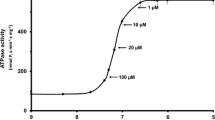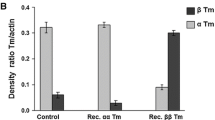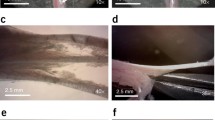Abstract
Previously it was shown that when troponin-C (TnC) is extracted from barnacle myofibrillar bundles they lose their Ca2+ sensitivity, which can be restored by adding back barnacle TnC (either isoform, BTnC1 or BTnC2). Thus barnacle muscle shows thin filament regulation, as does rabbit psoas skeletal muscle. In this paper we comp are the interactions of barnacle and rabbit fast muscle TnC in their respective muscles. We demonstrate that muscle fibres from the giant barnacle, Balanus nubilus, contain about 186 μm kg−1 muscle tissue of BTnC1 plus BTnC2 compared to about 91 μm kg−1 of TnC in rabbit psoas muscle fibres. Extraction of BTnC is achieved using similar low ionic strength, low divalent ion Ca2+-low Mg2+ conditions which are required for TnC extraction in rabbit psoas skinned muscle fibres; extraction was prevented by 1 mm Mg2+. Full reconstitution of Ca2+-sensitivity was achieved by adding back BTnC (1 + 2, or 2). Reconstitution of barnacle muscle with rabbit fast skeletal TnC (RTnC) was more complex, with partial recovery of Ca2+-sensitivity with reconstitution in the presence of 3 mm Mg2+ and more fully with reconstitution in the presence of activating Ca2+ (pCa 4.0). This suggests that the barnacle TnC-TnI (troponin I) recognition sites may be more complex than in rabbit because the barnacle sites appear to have at least two different conformations or types, in which one recognizes RTnC in the presence of Mg2+ and the other only in the presence of Ca2+ and Mg2+. This is consistent with the presence of several TnI isoforms in barnacle striated myofibrils. RTnC has two C-terminal Ca2+-Mg2+ binding sites that are thought to be involved in the Mg2+-sensitive binding of RTnC in rabbit muscle, yet it has been suggested that this site in barnacle muscle does not bind Mg2+, even though Mg2+ stabilizes BTnC binding in barnacle muscle. Consistent with this stabilizing action of Mg2+, using fluorescent probes IAANS or IAE on isolated BTnC2 we demonstrate that BTnC2 binds both Ca2+ and Mg2+, but the data do not suggest direct competition. Consistent with the C-terminal sites on BTnC being Ca2+-specific, BTnC1+2 could only reconstitute low levels of force (about 1/3) in TnC-extracted rabbit skinned muscle fibers in the presence of pCa 4.0 (not just Mg2+) and only at low ionic strengths (0.09 m). Ca2+-activation of contraction was further examined using fluorescently labelled BTnC2 (labelled with IANBD) incorporated into skinned barnacle myofibrillar bundles. Maximal Ca2+ binding produced structural changes in BTnC which resulted in a 45% decrease in the fluorescence compared to the value at pCa 9.2. The magnitude of the fluoresence decrease paralleled the increase in force with increas ing Ca2+. The Hill fits to the data gave pCa1/2 and n of 5.61 ± 0.02 and 2.06 ± 0.12 for force, and 5.52 ± 0.02 and 1.88 ± 0.10 for fluoresence. Removing MgATP to induce rigor in the fibre decreased BTnC2-NBD fluorescence only about 11%, but the addition of Ca2+ in rigor further decreased the fluorescence to a slightly larger extent than under maximal Ca2+ activating conditions. These fluorescence changes are qualitatively similar to the fluorescence enhancement seen with Ca2+-activation and rigor with RTnCDanz exchanged into rabbit psoas skinned muscle fibres. The data support a similar model for Ca2+-activation of force in barnacle muscle and in rabbit psoas skeletal muscle fibres
Similar content being viewed by others
References
ALLEN, T. StC., YATES, L. D. & GORDON, A. M. (1992) Ca2+ dependence of structural changes in troponin-C in demembranated fibers of rabbit psoas muscle. Biophys. J. 61, 399-409.
ASHLEY, C. C., LEA, T. J., HOAR, P. E., KERRICK, W. G. L., STRANG, P. F. & POTTER, J. D. (1991) Functional characterization of the two isoforms of troponin C from the arthropod Balanus nubilus. J. Muscle Res. Cell Motil. 12, 532-42.
BABU, A., ORR, G. & GULATI, J. (1988) Calmodulin supports the force-generating function in desensitized muscle fibers. J. Biol. Chem. 263, 15485-91.
BROZOVICH, F. V., YATES, L. D. & GORDON, A. M. (1988) Muscle force and stiffness during activation and relaxation: implications for the actomyosin ATPase. J. Gen. Physiol. 91, 399-420.
CHASE, P. B. & KUSHMERICK, M. J. (1988) The effects of pH on contraction of rabbit fast and slow skeletal muscle fibers. Biophys. J. 53, 935-46.
CHIU, Y., ASAYAMA, J. & FORD, L. E. (1982) A sensitive photoelectric force transducer with a resonant frequency of 6 kHz. Am. J. Physiol. 243, C299-C302.
COLLINS, J. H., THEIBERT, J. L., FRANCOIS, J.-M., ASHLEY, C. C. & POTTER, J. D. (1991) Amino acid sequences and Ca2+-binding properties of two isoforms of barnacle troponin. C. Biochemistry 30, 702-7.
DUBYAK, G. R. (1985) Inhibition of tension development and actomyosin ATPase in barnacle muscle by the Ca2+ indicator antipyrylazo III. J. Muscle Res. Cell Motil. 6, 275-92.
FABIATO, A. (1988) Computer programs for calculating total from specified free or free from specified total ionic concentrations in aqueous solutions containing metals and ligands. Meths Enzymol. 157, 378-417.
GIULIAN, G. G., MOSS, R. L. & GREASER, M. (1983) Improved methodology for analysis and quantitation of proteins on one-dimensional silver-stained slab gels. Anal. Biochem. 129, 277-87.
GRIFFITHS, P. J., DUCHATEAU, J. J., MAEDA, Y., POTTER, J. D. & ASHLEY, C. C. (1990) Mechanical characteristics of skinned and intact muscle fibres from the giant barnacle, Balanus nubilus. Pflugers Arch. 415, 554-65.
GUTH, K. & POTTER, J. D. (1987) Effect of rigor and cycling cross-bridges on the structure of troponin C and on the Ca2+ affinity of the Ca2+ specific regulatory sites in skinned rabbit psoas fibers. J. Biol. Chem. 262, 13627-35.
HELLAM, D. C. & PODOLSKY, R. J. (1969) Force measurements in skinned muscle fibres. J. Physiol. 200, 807-19.
HINKE, J. A. M. (1970) Solvent water for electrolytes in the muscle fiber of the giant barnacle. J. Gen. Physiol. 56, 521-41.
HOYLE, G. & SMYTH, T. (1963) Neuromuscular physiology of giant muscle fibers of a barnacle, Balanus nubilus Darwin. Comp. Biochem. Physiol. 10, 291-314.
HOYLE, G., McNEILL, P. A. & SELVERSTON, A. I. (1973) Ultrastructure of barnacle giant muscle fibers. J. Cell Biol. 56, 74-91.
LAEMMLI, U. K. (1970) Cleavage of structural proteins during assembly of head of bacteriophage. Nature 270, 680-5.
LEAVIS, P. C. & GERGELY, J. (1984) Thin filament proteins and thin filament-linked regulation of vertebrate muscle contraction. CRC Crit. Rev. Biochem. 16, 235-305.
LEHMAN, W. & SZENT-GYORGYI, A. G. (1975) Regulation of muscular contraction: Distribution of actin control and myosin control in the animal kingdom. J. Gen. Physiol. 66, 1-30.
LESZYK, J., GRABAREK, Z., GERGELY, J. & COLLINS, J. H. (1990) Characterization of zero-length cross-links between rabbit skeletal muscle troponin C and troponin I: evidence for direct interaction between the inhibitory region of troponin I and the NH2-terminal, regulatory domain of troponin C. Biochemistry 29, 299-304.
POTTER, J. D. (1982) Preparation of troponin and its subunits. Meths Enzymol. 85, 241-63.
QIAN, Y., GORDON, A. M. & LUO, Z. X. (1991) Exchange of TnC between rabbit and barnacle muscle fibers. Biophys. J. 59, 583a.
WNUK, W. (1988) Calcium binding to troponin C and the regulation of muscle contraction: a comparative approach. In Calcium and Calcium Binding Proteins: Molecular and Functional Aspects (edited by GERDAY, Ch., BOLIS, L. & GILLES, R.) pp. 44-68. Berlin: Springer-Verlag.
YATES, L. D. & GREASER, M. L. (1983) Troponin subunit stoichiometry and content in rabbit skeletal muscle and myofibrils. J. Biol. Chem. 258, 5770-4.
ZOT, H. G. & POTTER, J. D. (1982) A structural role for the Ca2+-Mg2+ sites on troponin C in the regulation of muscle contraction. J. Biol. Chem. 257, 7678-83.
Author information
Authors and Affiliations
Rights and permissions
About this article
Cite this article
Gordon, A.M., Qian, Y., Luo, Z. et al. Characterization of troponin-C interactions in skinned barnacle muscle: comparison with troponin-C from rabbit striated muscle. J Muscle Res Cell Motil 18, 643–653 (1997). https://doi.org/10.1023/A:1018631806182
Issue Date:
DOI: https://doi.org/10.1023/A:1018631806182




